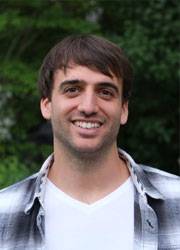Yanick Volpez
ContactDepartment of PhysicsUniversity of Basel Klingelbergstrasse 82 CH-4056 Basel, Switzerland
|

|
Short CV
| 2016-present: | Ph.D. student in the Condensed Matter Theory & Quantum Computing group at the University of Basel, supervisors: Prof. Klinovaja and Prof. Loss |
| 2015/2016: | Master's Thesis: 'Correlated Fermions on Hexagonal Lattices from the Functional Renormalization Group' under the supervision of PD Dr. Michael Scherer |
| 2014-2016: | M.Sc. Physics Degree at Heidelberg University |
| 2013/2014: | Bachelor's Thesis: 'Calculation of Two-Loop Master Integrals for qq -> VV' under the supervision of Prof. Thomas Gehrmann |
| 2010-2014: | B.Sc. Physics Degree at University of Zurich |
Publications
Show all abstracts.| 1. | Time-Reversal Invariant Topological Superconductivity in Planar Josephson Bijunction |
| Yanick Volpez, Daniel Loss, and Jelena Klinovaja. arxiv:1910.06921
We consider a Josephson bijunction consisting of a thin SIS π-Josephson junction sandwiched between two-dimensional semiconducting layers with strong Rashba spin-orbit interaction. Each of these layers forms an SNS junction due to proximity-induced superconductivity. The SIS junction is assumed to be thin enough such that the two Rashba layers are tunnel-coupled. We show that, by tuning external gates, this system can be controllably brought into a time-reversal invariant topological superconducting phase with a Kramers pair of Majorana bound states being localized at the end of the normal region for a large parameter phase space. In particular, in the strong spin-orbit interaction limit, the topological phase can be accessed already in the regime of small tunneling amplitudes.
| |
| 2. | Second Order Topological Superconductivity in $\pi$-Junction Rashba Layers |
| Y. Volpez, D. Loss, and J. Klinovaja. Phys. Rev. Lett. 122,126402 (2019)
We consider a Josephson junction bilayer consisting of two tunnel-coupled two-dimensional electron gas layers with Rashba spin-orbit interaction, proximitized by a top and bottom s-wave superconductor with phase difference $\phi$ close to $\pi$. We show that, in the presence of a finite weak in-plane Zeeman field, the bilayer can be driven into a second order topological superconducting phase, hosting two Majorana corner states (MCSs). If $\phi=\pi$, in a rectangular geometry, these zero-energy bound states are located at two opposite corners determined by the direction of the Zeeman field. If the phase difference $\phi$ deviates from $\pi$ by a critical value, one of the two MCSs gets relocated to an adjacent corner. As the phase difference $\phi$ increases further, the system becomes trivially gapped. The obtained MCSs are robust against static and magnetic disorder. We propose two setups that could realize such a model: one is based on controlling $\phi$ by magnetic flux, the other involves an additional layer of randomly oriented magnetic impurities responsible for the phase shift of $\pi$ in the proximity-induced superconducting pairing.
| |
| 3. | Rashba Sandwiches with Topological Superconducting Phases |
| Y. Volpez, D. Loss, and J. Klinovaja. Phys. Rev. B 97,195421 (2018)
We introduce a versatile heterostructure harboring various topological superconducting phases characterized by the presence of helical, chiral, or unidirectional edge states. Changing parameters, such as an effective Zeeman field or chemical potential, one can tune between these three topological phases in the same setup. Our model relies only on conventional nontopological ingredients. The bilayer setup consists of an s-wave superconductor sandwiched between two two-dimensional electron gas layers with strong Rashba spin-orbit interaction. The interplay between two different pairing mechanisms, proximity induced direct and crossed Andreev superconducting pairings, gives rise to multiple topological phases. In particular, helical edge states occur if crossed Andreev superconducting pairing is dominant. In addition, an in-plane Zeeman field leads to a two-dimensional gapless topological phase with unidirectional edge states, which were previously predicted to exist only in noncentrosymmetric superconductors. If the Zeeman field is tilted out of the plane, the system is in a topological phase hosting chiral edge states.
| |
| 4. | Three-Dimensional Fractional Topological Insulators in Coupled Rashba Layers |
| Y. Volpez, D. Loss, and J. Klinovaja. Phys. Rev. B 96, 085422 (2017)
We propose a model of three-dimensional topological insulators consisting of weakly coupled electron- and hole-gas layers with Rashba spin-orbit interaction stacked along a given axis. We show that in the presence of strong electron-electron interactions the system realizes a fractional strong topological insulator, where the rotational symmetry and condensation energy arguments still allow us to treat the problem as quasi-one-dimensional with bosonization techniques. We also show that if Rashba and Dresselhaus spin-orbit interaction terms are equally strong, by doping the system with magnetic impurities, one can bring it into the Weyl semimetal phase.
| |
| 5. | Electronic instabilities of the extended Hubbard model on the honeycomb lattice from functional renormalization |
| Y. Volpez, D. D. Scherer, and M. M. Scherer. Phys. Rev. B 94, 165107 (2016)
Interacting fermions on the half-filled honeycomb lattice with short-range repulsions have been suggested to host a variety of interesting many-body ground states, e.g., a topological Mott insulator. A number of recent studies of the spinless case in terms of exact diagonalization, the infinite density matrix renormalization group and the functional renormalization group, however, indicate a suppression of the topological Mott insulating phase in the whole range of interaction parameters. Here, we complement the previous studies by investigating the quantum many-body instabilities of the physically relevant case of spin-1/2 fermions with onsite, nearest-neighbor and second-nearest-neighbor repulsion. To this end, we employ the multi-patch functional renormalization group for correlated fermions with refined momentum resolution observing the emergence of an antiferromagnetic spin-density wave and a charge-density wave for dominating onsite and nearest-neighbor repulsions, respectively. For dominating second-nearest neighbor interaction our results favor an ordering tendency towards a charge-modulated ground state over the topological Mott insulating state. The latter evades a stabilization as the leading instability by the additional onsite interaction.
|
